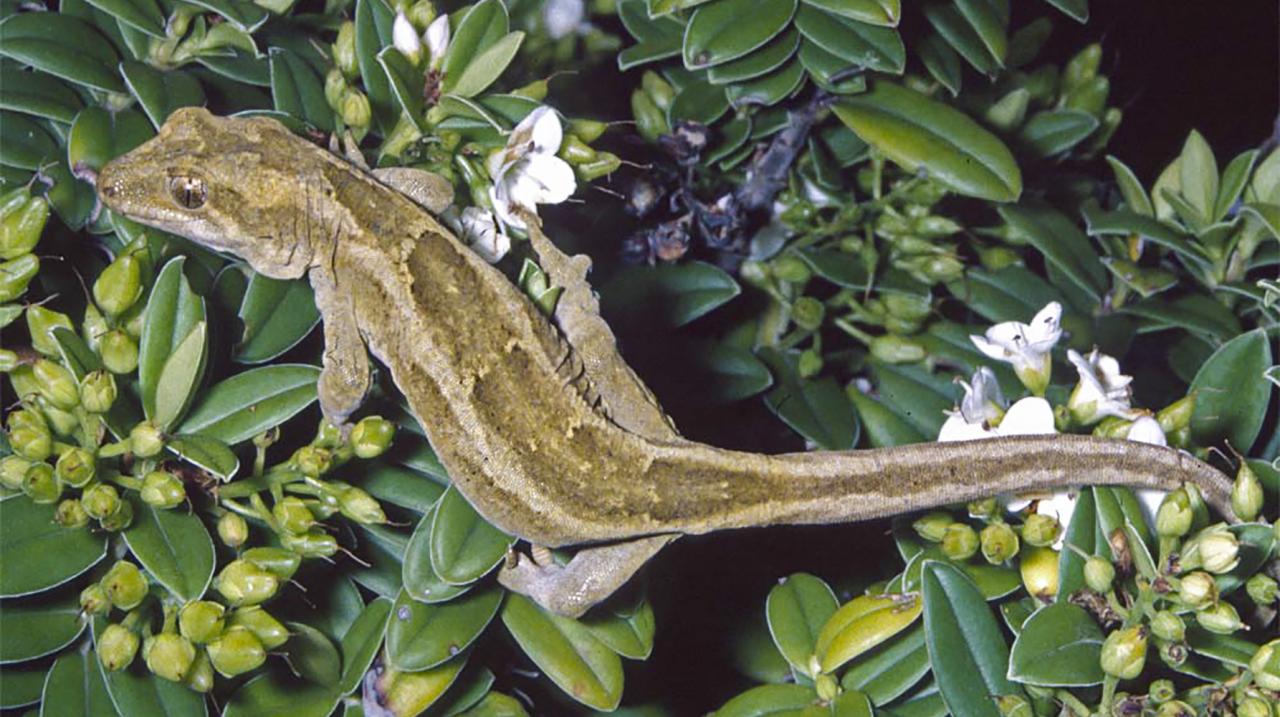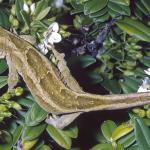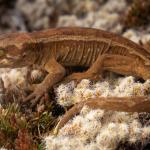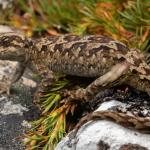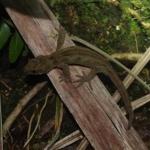- Home
- Herpetofauna Index
- Native
- Mokopirirakau "Open Bay Islands"
Mokopirirakau "Open Bay Islands"
Open Bay Islands gecko
Mokopirirakau "Open Bay Islands"
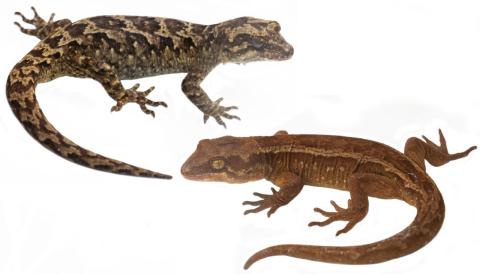
Length: SVL up to 80mm, with the tail being equal to or shorter than the body length
Weight: up to 10.7 grams
Description
A unique species of Mokopirirakau that was once considered restricted to the Open Bay Islands off the western coast of Haast in southern Westland. Historically this species was considered the smallest member of the Mokopirirakau genus, however, the discovery of a distinct alpine population on the adjacent mainland in 2021 was markedly larger, and thus it has been theorised that the island population may show dwarfism in response to the available habitat on the small island (Taumaka - 20 hectares). Although genetically similar, these populations are fairly distinctive, showcasing differences in both pattern and colouration.
Open Bay Islands:
This population is relatively drab compared to other Mokopirirakau, being a uniform light brown or olive with beige dorsolateral stripes and transverse bands which often result in distinct U-shape patterns running down the back of the animal. A distinct arrow-shaped marking is present between the eyes pointing towards and often joining with the dorsal pattern. The lateral (sides), and ventral (belly) surfaces are a similar light brown to olive as the dorsal surfaces but fade to lighter tones on the undersides. The mouth lining and tongue of this species are bright orange in colouration.
Mainland (Alpine):
This population is characterised by its much brighter and contrasting dorsal colouration and pattern. In general, their dorsal surfaces range from light brown through to rusty-brown/orange, with this background colouration being broken up by much lighter (light brown to white) dorsolateral stripes, and dark transverse bands/blotching. A distinct V-shaped marking is present between the eyes in the middle of the head, whilst a pale (light brown to white) stripe, bordered by darker pigments runs diagonally from the lower eye through to the ear. The lateral surfaces (sides) are much the same as the dorsal surfaces but may have pale dots speckled over them. The ventral surface (stomach) is brown to light brown, and often has pale speckling (light brown to orange), giving a mottled appearance, with the throat often being similar in colour to the speckling. The mouth lining and tongue of this species are bright orange in colouration.
Life expectancy
Largely unknown, however, captive Mokopirirakau have frequently been known to live for upwards of 25 years, with some individuals topping the records at 40+ (D. Keal pers. comm 2016). The maximum age for wild animals is not known, however, it is likely that they can live at least as long as captive animals, if not longer.
It is theorised that alpine populations of Mokopirirakau may have longer lifespans than their lowland cousins due to the reduced metabolic activity of these species over extended periods of time. If this is the case it wouldn't be unfair to assume that these species could live well into their 80s, or even reach ages in excess of 100 years.
Distribution
Although once considered to be restricted to Taumaka island in the Open Bay Island group, it was recently (2021) discovered in the subalpine/alpine zones on the adjacent mainland.
Ecology and habitat
The Open Bay Islands gecko is nocturnal (active at night), although may cryptically bask during the day. As with many members of the Mokopirirakau genus they are primarily arboreal (tree-dwelling), but in certain habitats (subalpine/alpine) they are almost exclusively terrestrial (ground-dwelling). Lowland (forest dwelling) populations possess a strongly prehensile tail which acts as a third-limb/climbing aid when moving through shrubs and trees. They are known to occasionally mouth-gape and produce a high-pitched squealing sound when threatened by potential predators.
Open Bay Islands geckos are closely associated with a range of different habitats on both Taumaka, and the adjacent mainland, these include; coastal forest, scrubland, boulderfield, and tussockland/rocky herbfields. On Taumaka, dense vegetation such as the terrestrial growth form of kiekie (Freycinetia banksii) may serve as a major stronghold, particularly in the presence of weka.
Social structure
The Open Bay Islands gecko is solitary in nature, although it is thought that they may share refugia with congeners during the winter. As is the case with other Mokopirirakau it is theorised that males likely show aggression to other males during the breeding season. Neonates (babies) are independent at birth.
Breeding biology
As with all of Aotearoa's gecko species, the Open Bay Islands gecko is viviparous, giving birth to one or two live young annually, or biennially (once every two years). It is not known when females birth, but they have been recorded as being gravid in March. Mating in Mokopirirakau may seem rather violent with the male repeatedly biting the female around the neck and head area. Sexual maturity is probably reached between 1.5 to 2 years as with other Mokopirirakau, however, in alpine populations, it may take up to 4 years.
Diet
Open Bay Islands geckos are omnivores. They are primarily insectivorous in nature, but are also known to feed on the nectar, and small fruits of several plant species when they are seasonally available. With the lowland population being primarily arboreal, and the alpine population primarily terrestrial it is likely that food sources differ between them. The diet of lowland populations is likely to be predominantly composed of flying insects (moths, flies, beetles, etc.), and small spiders, whilst alpine populations probably take more terrestrial prey (crickets/grasshoppers, ground-dwelling beetles, and some moth species).
Disease
The diseases and parasites of Aotearoa's reptile fauna have been left largely undocumented, and as such, it is hard to give a clear determination of the full spectrum of these for many species.
The Open Bay Islands gecko, as with other Mokopirirakau species, is a likely host for at least one species of endoparasitic nematode in the Skrjabinodon genus (Skrjabinodon poicilandri), as well as at least one strain of Salmonella. In addition to this, it is known to be a host for at least one species of ectoparasitic mite - potentially Neotrombicula naultini as this species is known to occur on other members of the Mokopirirakau genus.
Wild Mokopirirakau have been found with Disecdysis (shedding issues).
Conservation strategy
The Open Bay Islands gecko is regarded as 'Threatened - Nationally Endangered' due to both its restricted distribution, and small population. This species is exposed to predation from Weka (introduced in the early 1900s) on Taumaka island, and along with the co-occurring Taumaka skink (Oligosoma taumakae) would benefit from the removal or control of them.
The recent discovery of a mainland population may point to this species being less threatened than once thought, however, the distinctive population on Taumaka is still highly threatened and requires imminent conservation efforts.
Interesting notes
The Open Bay Island's gecko gets both its common and TAG names from the island group where it was first discovered.
The Open Bay Island's gecko was first discovered in April 1970 by botanist Colin Burrows when he found two small geckos amongst a dense patch of vegetation on Taumaka, however, after this discovery they remained unseen for a further 19 years. They were rediscovered by Canadian herpetologist Bob St. Clair in 1989.
For many years it had been theorised that this species was likely to occur on the West Coast mainland, due to the shallowness between the Open Bay Islands, and the adjacent landmass. However, it wasn't until 2021 that this theory came to fruition, when a population was discovered in the mountain ranges to the east of Taumaka.
"Moko-piri-rakau" is the Maori name for forest gecko, and means 'lizards that clings to trees.'
The Open Bay Islands gecko, along with its sister taxa (the Cascade gecko) sit within the western clade of the Mokopirirakau genus, with the broad-cheeked gecko being their closest relative within the group.
References
Hitchmough, R.A., Barr, B., Lettink, M., Monks, J., Reardon, J., Tocher, M., van Winkel, D., Rolfe, J. (2016). Conservation status of New Zealand reptiles, 2015; New Zealand threat classification series 17. Wellington: New Zealand Department of Conservation.
Jewell, T. (2011). A photographic guide to reptiles and amphibians of New Zealand. Auckland: New Holland Publishing.
van Winkel, D., Baling, M. & Hitchmough, R. (2018). Reptiles and Amphibians of New Zealand: A field guide. Auckland: Auckland University Press, 376 pp.

